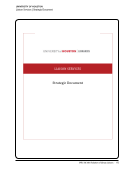SPEC Kit 349: Evolution of Library Liaisons · 57
Bioinformatics support clinical rounding services mediated literature searching providing assistance with/co-
authorship on systematic reviews creating and teaching credit-bearing courses, such as “Human Bioinformatics” or
credit-bearing honors college courses related to National Library of Medicine exhibits organizing and implementing
center or institute seminar series or annual conferences teaching workshops on the NIH Public Access Policy
compliance, medical terminology, bioinformatics resources, and best practices in data management.
Co-hosting of events &programs at library
Community outreach and education to various constituents
Connecting to functional specialists, connecting to other relevant liaisons
Creating online subject guides. Providing support for citation analysis for faculty evaluation, promotion. Participation in
library and campus committees.
Creating research guides and support materials
Cultivating subject and interdisciplinary knowledge, keeping abreast of new technologies
Data research and identification, office hours, virtual reference, LibGuides
Digital scholarship, impact metrics
Event planning is not necessarily a core duty but is expected from the group of liaisons as a whole. A few have taught
semester-long research or IL classes but it’s not a core duty. Liaisons collaborate with other our data curation program
on data management consultations.
Liaison’s role in managing library collection is changing as we change our print/electronic collections management
processes. While most of our liaison are no longer staffing the reference desk, there are some small branches where this
is still a core role.
Liaisons are the initial point of contact for faculty seeking library services. Some liaisons provide teaching of IL classes
others collaborate with reference and instruction librarians to provide these services.
New competencies added as a result of 2014 revision: Knowledge and advocacy for the use of digital tools (e.g., Zotero,
DMP tool, etc.)
Not all liaisons do all of these but they have access to other librarians to whom they can refer. Most are involved in
teaching, consulting on, and doing systematic reviews and other extensive research work. Some liaisons are learning
basics of data management planning, data visualization, data repositories, and related support. They all help users with
compliance with public access policies from research agencies. They all help users set up research alert services and
dynamic embedded searches of resources like PubMed and the catalog. All provide expertise in presenting professionally
from poster critique to finding publishing venues (including open access) and we have an instructional design specialist
for consults regarding working with images, poster creation, visual literacy, and similar concepts. Finding grant funding,
teaching, and helping faculty, staff, and students use the funding sources tools is another popular service. I know I’m
forgetting others!
NOTE: Our institution does not offer semester/quarter-long information literacy courses.
One liaison teaches a semester-long IL course related to her department, but this is not the norm.
Our Science &Engineering Library has on-call reference support they do not staff that desk.
Participation in curriculum planning, grand rounds, morning report, journal club, systematic reviews, etc.
Bioinformatics support clinical rounding services mediated literature searching providing assistance with/co-
authorship on systematic reviews creating and teaching credit-bearing courses, such as “Human Bioinformatics” or
credit-bearing honors college courses related to National Library of Medicine exhibits organizing and implementing
center or institute seminar series or annual conferences teaching workshops on the NIH Public Access Policy
compliance, medical terminology, bioinformatics resources, and best practices in data management.
Co-hosting of events &programs at library
Community outreach and education to various constituents
Connecting to functional specialists, connecting to other relevant liaisons
Creating online subject guides. Providing support for citation analysis for faculty evaluation, promotion. Participation in
library and campus committees.
Creating research guides and support materials
Cultivating subject and interdisciplinary knowledge, keeping abreast of new technologies
Data research and identification, office hours, virtual reference, LibGuides
Digital scholarship, impact metrics
Event planning is not necessarily a core duty but is expected from the group of liaisons as a whole. A few have taught
semester-long research or IL classes but it’s not a core duty. Liaisons collaborate with other our data curation program
on data management consultations.
Liaison’s role in managing library collection is changing as we change our print/electronic collections management
processes. While most of our liaison are no longer staffing the reference desk, there are some small branches where this
is still a core role.
Liaisons are the initial point of contact for faculty seeking library services. Some liaisons provide teaching of IL classes
others collaborate with reference and instruction librarians to provide these services.
New competencies added as a result of 2014 revision: Knowledge and advocacy for the use of digital tools (e.g., Zotero,
DMP tool, etc.)
Not all liaisons do all of these but they have access to other librarians to whom they can refer. Most are involved in
teaching, consulting on, and doing systematic reviews and other extensive research work. Some liaisons are learning
basics of data management planning, data visualization, data repositories, and related support. They all help users with
compliance with public access policies from research agencies. They all help users set up research alert services and
dynamic embedded searches of resources like PubMed and the catalog. All provide expertise in presenting professionally
from poster critique to finding publishing venues (including open access) and we have an instructional design specialist
for consults regarding working with images, poster creation, visual literacy, and similar concepts. Finding grant funding,
teaching, and helping faculty, staff, and students use the funding sources tools is another popular service. I know I’m
forgetting others!
NOTE: Our institution does not offer semester/quarter-long information literacy courses.
One liaison teaches a semester-long IL course related to her department, but this is not the norm.
Our Science &Engineering Library has on-call reference support they do not staff that desk.
Participation in curriculum planning, grand rounds, morning report, journal club, systematic reviews, etc.












































































































































































































